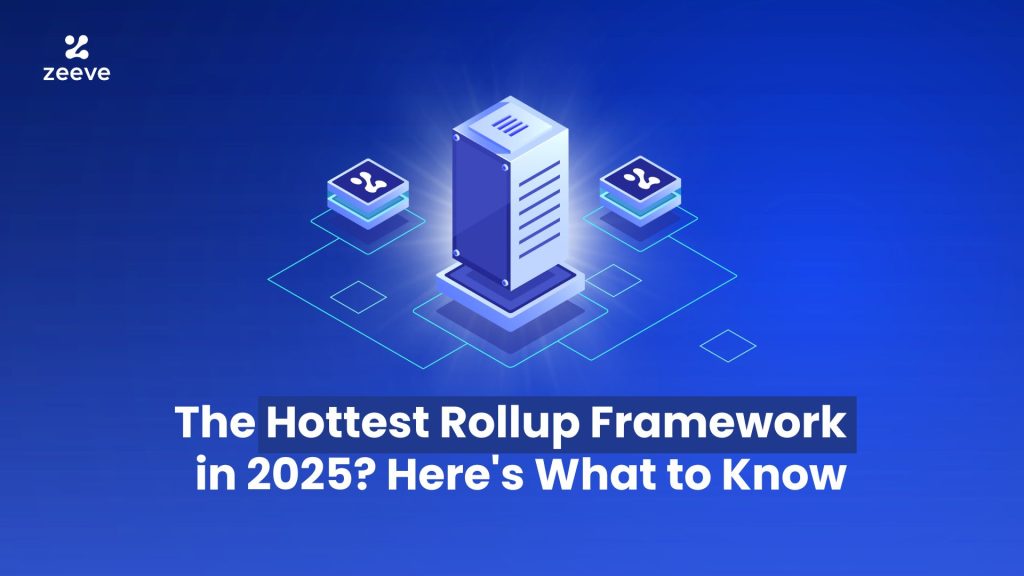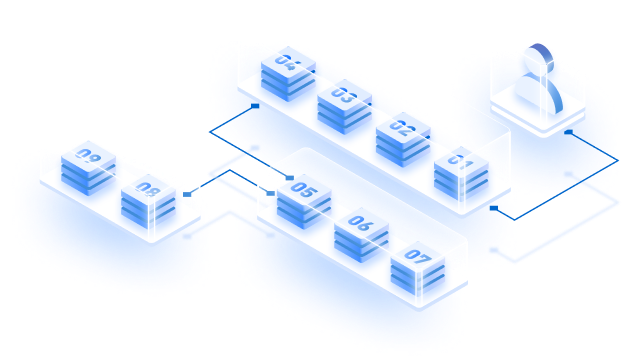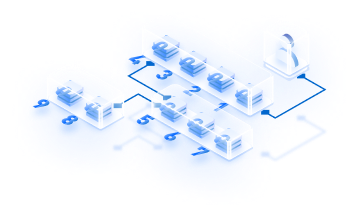Whether we talk about Rollups’ state in 2024 or the current year, L2 rollups have gained unrealistic growth & adoption with $10.22B TVL, $31.25B TVS, and close to 400 chains launched already. Ethereum’s pro-dank sharding upgrade, Stage-1 decentralization, Dencun upgrade, Optimism’s Bedrock upgrade, Polygon’s AggLayer, and Elastic Network from ZKSYNC are the major reasons behind this tremendous growth.
Due to such popularity, choosing the Rollups framework can be really a challenge, especially when both the optimistic and ZK rollups have achieved almost the same level of maturity. The best way is to finalize a stack to see what are its top features that founders love the most. And, that’s exactly the analysis we’ll do in this article along with a brief conclusion to solve this dilemma. Let’s begin!
What are the Best Rollup Frameworks and top reasons for L2s to choose them?
At present, 4 major rollup frameworks are relevant in the industry. This includes OP Stack, Arbitrum Orbit, ZKsync Hyperchain, and Polygon CDK, which have been shortlisted on the basis of their powerful tech stack, adoption, community growth, and more. Now, let’s dive deeper and understand what features of these stacks are loved by the founders of top L2/L3 projects:
- Optimistic Rollups- OP Stack and Arbitrum Orbit.
- ZK Rollups- Polygon CDK and ZKsync ZK Stack (Hyperchains).
We’ll first deep dive into optimistic rollups and then move to ZK Rollups:
OP Stack
OP Stack holds the momentum of being one of the matured and early provider of OP L2/L3 rollups popular and is currently having 17M+ daily transactions, 67.1% L2 market share, and 32+ chains already on the mainnet; of which 4 chains that have achieved Stage-1 decentralization.
Below are the key features of OP Stack ,most loved by founders:
1.Dynamic fee mechanism- OP Stack allows Layer2s to adopt a dynamic fee mechanism, powered by EIP-1559. This allows chains to set up a base fee that fluctuates based on the network traffic effects & usage. Also, EIP-1559 enables the users to add priority fee (or tip) to incentivize faster transaction processing.
Soneium- Sony’s Layer2 blockchain with its 7M ecosystem, close to 250 projects, and $130M TVL is utilizing OP Stack’s dynamic fee system, along with its all other unique features.

2.1-second Blocktime– After the recent upgrade, OP Stack has been optimized to offer 1-second blocktime and it will soon achieve 200ms blocktime. This is a great USP for DeFi and Gaming projects that seek very high blocktime to handle massive traffic on their chains.
Unichain, built by Uniswap, is another popular and high-traction OP Stack chain with around $870M DeFi TVL, 119.46M + transactions, 475k+ smart contracts deployed, and 6M+ active wallets. Unichain has achieved 200ms blocktime for reduced MEV issues and faster blocks.
Introducing @unichain — a new L2 designed for DeFi ✨
— Uniswap Labs 🦄 (@Uniswap) October 10, 2024
Fast blocks (250ms), cross-chain interoperability, and a decentralized validator network
Built to be the home for liquidity across chains pic.twitter.com/lqfJh6Ltio
3. 40-50 blobs per block milestone- To fasten up the network and improve the performance, OP Stack has set a target of 40-20 blobs per block. This will allow chains to handle 300-400 TPS, which they can decide as per network’s traffic.
Base (a Coinbase project), identifies as a top OP Stack L2 with $3.371B DeFi TVL and 400+ projects and more than 80% of OP Stack transactions. With the OP Stack framework, Base is getting 10-100X less network fee, great response time with 20-50 blobs per block, 300-400 TPS, and OP Stack’s fundamental features.
4. Highly modular stack– Modularity is one of key USPs of rollup stack, and that’s where OP Stack thrives. OP Stack allows chains to use alternative DA layer, sequencer, and other rollup components that are pluggable. Also, it supports rollups-as-a-service (RaaS) solutions for quick launch & management of L2s/L3s. Modular stack to include external DA Layer, Sequencer, execution layer, proof layer, etc.
All the top projects in Superchain- be it Base, Soneium, Unichain, Mode, or Zora, each uses this modularity for their custom rollup.
Want more information on Superchain? Read the article linked below:
The Biggest Catalysts for Superchain Growth in 2025
Arbitrum Orbit
Arbitrum Orbit with more than 28% of aggregated rollup TVL, 16+ chains on mainnet, and 285b TVL, is a strong player in the Layer2 rollups space. With its 2025’s technical roadmap, Orbit is advancing its security, scalability, and decentralization, here’s a tweet:
Arbitrum Roadmap 2025@Arbitrum's development #roadmap for the second half of 2024 through 2025 focuses on advancing decentralization and enhancing scalability.
— Upside GM 👋 (@gm_upside) August 24, 2024
Key metrics over the past three months:
– Daily active addresses
– Daily transactions
– TVL
– Price
Data source:… pic.twitter.com/Mp6ItZRuo5
Also, below are key Orbit’s key features that are loved by the founders to top Orbit L2s/L3s:
- Full EVM compatibility with Stylus– With launch of Stylus, Orbit chains have been utilizing a seamless Ethereum alignment for faster and more efficient environment. Plus, Stylus allows Orbit L2s/L3s to get the battle-tested security & liquidity from Ethereum. Read more about Arbitrum Stylus from this in-depth article.
All the top Orbit chains; Ape chain, EDU chain, SX Rollup, Xai, Superposition, Duckchain, and Rari have chosen Orbit for its Stylus upgrade, besides all its other USPs. - Support for Custom token- Arbitrum Orbit has already upgraded its stack to support custom tokens. Chains can now choose between ETH, ARB, or their own native token. Custom token is one of the much-requested features since launch of Arbitrum Orbit, and its empowering projects to build rollups with native economic incentives.
Ape Chain ( $9.86M TVL, contribution to more than 75% of Orbit TVL and is currently home to 17 protocols) is using $APE as their native gas token, instead of $ARB. - Faster block time- Fastest block time is one of the top-notch Orbit’s features. L2/L3 chains now offer 250ms block time, which is around 8x faster than Polygon’s blocktime. With such fast block time, chains achieve high-transaction speed, improved user experience, and more stable security for their future-proof ecosystem.
EDU Chain (aggregated 1.35M TVL 30+ live (100+ in building) projects in leading categories like AI, DeFi, Gaming, and Infrastructure) is using Orbit’s fast block time, apart from its modularity. Stylus-based Ethereum compatibility, etc. - BolD for permissionless validation– As a major step towards stage-2 decentralization, Arbitrum Orbit launched BoLD or Bounded Liquidity Delay in February 2025 for a true, permissionless system of validation, which also enables challenges resolution in a fixed timeframe window.
- Multiplied revenue source- Rollups on Orbit ecosystem are able to generate sequencer revenue from each transaction that is processed on their chain. For high-traction chains, this source of revenue proves to be a substantial income, which is beyond the traditional model of collecting a standard commission fee.
SX Rollup, having $1.02M TVL, contributes to around 8% of Arbitrum Orbit’s total TVL and is the 3rd largest L2 ecosystem. Here are the top reasons for SX Rollup to choose Orbit:
Also, a key offering of Arbitrum Orbit is bypassing the 7-day withdrawal concept that has been a pain point in optimistic rollups. Read more information from this tweet:
The days of waiting 7 days to move your assets are gone.
— Arbitrum (@arbitrum) October 24, 2024
Fast Withdrawals is now supported with select Orbit chains and RaaS providers, allowing asset withdrawals to your settlement chain as fast as 15 minutes!
Move your assets onchain, offchain, any chain. More details 🧵 pic.twitter.com/bpzCgjJ2vh
AggLayer CDK (Prev. Polygon CDK)
Polygon CDK, now widely known as AggLayer CDK has gained widespread popularity and it’s home to 21+ chains (mainnet+testnet). Below are the key CDK’s features that top founders appreciates about AggLayer CDK:
1. v0.3 upgrade– Under v0.3 upgrade, AggLayer CDK is offering a unique execution proof that enables chains to prove their state independently and update the state really fast. Other main features in this upgrade is the ability for PoS chains to connect to AggLayer (by the end of Q3) for unified liquidity, get chain-agnotic capabilities, and use fast interop to thrive without interruption. V0.3 upgrade is new, and it will be soon by all the leading CDK chains; IoTex, dydx, Astar, Canto, Gnosis Pay, Palm Network, Aavegotchi, CapX, Wirex Pay, IDEX, Nubank, GameSwift, Powerloom, Manta Network, etc.
2. CDK OP Stack and CDK Erigon– As a major attempt to unify the web3, AggLayer CDK has introduced CDK OP Stack and CDK Erigon. With CDK OP Stack, projects can launch low-cost, highly-performant OP Stack L2/L3s that are connected to AggLayer without paying any tax; AggLayer does not seek rent.
On the other side, Erigon allows for custom tokens, ZK-based security, and dedicated high throughput. Here’s a tweet;
Use whatever stack you want.
— Sandeep | CEO, Polygon Foundation (※,※) (@sandeepnailwal) May 20, 2025
Proof-of-whatever. zk-whatever. It's all good.
Agglayer CDK supports CDK-Erigon and CDK-OP Stack, with more coming soon. pic.twitter.com/Jeor8Fdilg
Kraken, a new project, has confirmed utilizing CDK’s OP Stack-powered proof for its upcoming rollup chain.
3. 600X more speed and throughput than Ethereum- AggLayer chains have the privilege to enjoy 600X better speed and throughput capacity than Ethereum. This allows ZK Rollups to offer an impressive UX, ensure cutting-edge performance, and thus maintain sustainability without fail. These capabilities are further complimented through CDK’s zero gas fee or gasless transactions, and Ethereum-based security.
The gaming giant- Immutable Network with around $18M TVL, 5+ mainnet protocols, and 4M+ transactions (as of June, 2025) has launched game-powered ZK L2- ImmutableX using Polygon CDK to achieve 600X better speed and throughput than Ethereum while also having gasless transactions for impressive UX.
4. Strong dev community with full-fledged tools- Since transition to AggLayer CDK, and even before that, Polygon is recognized for offering high-end developer tools, such as open-source AggLayer CDK & Plonky3, powerful dApp launchpad, chain indexer framework, wallets, faucets, and more. All these tools fast-track development of CDK chains, thus saving significant time and resources for each project.
OKX- a promising DeFi project with around $29B assets, 446.75M transactions, and 15.4M total addresses has picked AggLayer CDK for this specific factor while it also utilizes other features like unified liquidity, custom token, and more.
Besides these, the e-commerce giant Flipkart also showed its interest in building with CDL to have its own ZKEVM chain for dedicated blockspace, custom native token, data privacy, and future-proof interoperability, though there’s no official news around exact launch timeline.
ZKsync Stack/ Hyperchain
Zksync Hyperchain’s ZK Stack has proved to be a future-ready ZK Rollup stack with $100.47M+ TVL, 160+ protocols, and 5+ biggest L2 live on mainnet. Zksync has rolled out a range of features that founders love, here’s an overview:
- Rollup infrastructure to offer 10k TPS- In their 2025’s roadmap, ZKsync has offered 10k TPS, which has quickly made it a top-choice for L2/L3 builders.
Swiss Bank; World’s largest bank; Swiss bank has shown interest in ZK Stack for this 10k TPS feature. Swiss Bank also highlights other features like dedicated L2 to provide UBS privacy needs, near zero gas fee, ERC token support, etc. - Sub-zero fees for low transaction- Considering that high-transaction fees is the major concern for many projects, ZKsync has offered sub-zero fees as another offering in its 2025 roadmap. This has allowed chains to offer network fees as low as $0.0001; thereby achieving economic freedom.
Abstract; the Hyperchain with $27M+ TVL and a full-fledged ecosystem of 18+ protocols uses ZK Stack for this low fees and key features like massive scaling through ZK Stack+Validium, interoperability with Elastic chains, powerful ecosystem for AI Agents, etc.
- Enhanced security through zkTLS- Zero-Knowledge Transport Layer Security (zkTLS) allows users on rollups to verify website data without revealing sensitive information with zero-knowledge proofs. Built on the TLS protocol, it connects Web2 and Web3 securely. Top use cases of zkTLS include identity chains, DeFi chains, and data sharing solutions. zkTLC is the top choice for each Hyperchain, including Cronos zkEVM and Zero Network that are high in TVL.
- Seamless integration with 3rd party services: Hyperchains have already identified the rise of custom rollup chains, hence it supports integration for almost each 3rd party services, be it DA layer, bridge, decentralized sequencer, wallets, and more components.
Sophon; the 2nd largest ZK chain in the Elastic chain ecosystem with 14M+ TVL, has built with ZK Stack due to its seamless modularity to plug-in with services like Layerzero and EigenDA, etc.
Also, the recent additions in ZKsync Hyperchain like ZKsync Airbender, ZKsync Prividium, Full-EVM equivalency are one-of-a-kind features that are enough to attract future-ready L2/L3 projects. Below are the tweets:
On an H100 GPU Airbender reaches ~21.8 MHz base proving speed on a standardized benchmark, followed by 3.45 MHz for SP1 Turbo and 1.1 MHz for RiscZero.
— ZKsync (∎, ∆) (@zksync) June 24, 2025
Airbender is ~6x faster than the closest contender. pic.twitter.com/6wyRZpzlYm
1/ Today we celebrate a big milestone: ZKsync is now fully EVM Equivalent! 🎉🧵👇 pic.twitter.com/Ai70W4RuMG
— ZKsync (∎, ∆) (@zksync) May 6, 2025
Which is the best Rollup Framework for your L2/L3 project?
As we’ve seen, each rollup stack has its specific benefits to offer to Layer2s along with some sort of improvement areas as well. For example, Optimistic Rollups are considered to be more matured and are mainnet-ready, compared to ZK Rollups. However, ZK Rollups are the top-choice for speed & security.
Likewise, each framework also has something unique to offer to Layer2s. For example, Native interoperability is now enabled in OP Stack- Superchain, Polygon CDK- AggLayer, and ZK Stack- ZKsync Elastic chain; it is yet to come on Arbitrum Orbit. But, Orbit supports custom tokens (gas and native token) which has recently been deprecated from OP Stack. Polygon CDK and ZKsync Hyperchains also support custom tokens. Also, ZK Stack takes a lead with its claims of 10k+ TPS and $0.0001 fees.
Based on the whole analysis, we can say that features like modularity, Ethereum-security, or performance are common in all the stacks; but Arbitrum Orbit and ZKsync Hyperchains are quite a forerunner due to their exciting upgrades.
Launch Your Own L2/L3 Rollup in minutes with Zeeve RaaS
Regardless of which rollup stack suits your project the best, you easily spin up your own Rollup DevNet in minutes and mainnet in a few weeks. Zeeve’s RaaS platform is optimized to enable modularity with 40+ integrations and pluggable solutions. Plus, your chain will be monitored 24/7 to ensure uninterrupted operations. Set up a call with our web3 experts or send all your queries via email to us. We will handle all your queries and also set up a demo to provide you a clear overview of our RaaS offerings. Also, you can set up your L2/L3 chain’s testnet all by yourself. Try Now!





